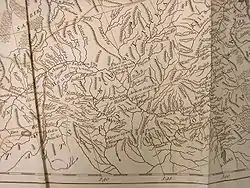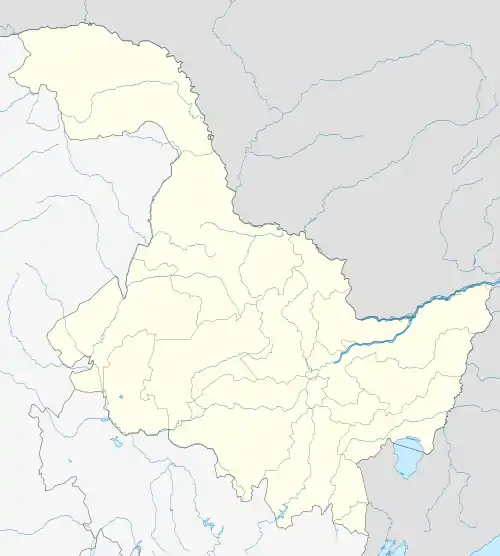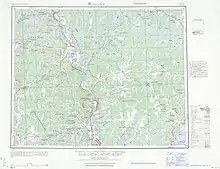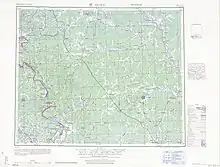Huma County
Huma County (simplified Chinese: 呼玛县; traditional Chinese: 呼瑪縣; pinyin: Hūmǎ xiàn; Manchu: Hūmar Siyan; Russian: Кумары) is a county in the far north of the Heilongjiang province, People's Republic of China. The county seat is located on the right (southwestern) bank of the Amur River, a few kilometers upstream from the fall of the Huma River (formerly also known as Houmar) into the Amur. It is under the administration of the Daxing'anling Prefecture.
Huma County
呼玛县 | |
|---|---|
 The Huma River was shown as Houmar on early maps (1773), the surrounding region labeled Houmari | |
.png.webp) Huma County (red) in Daxing'anling Prefecture (yellow) and Heilongjiang | |
 Huma Location of the seat in Heilongjiang | |
| Coordinates: 51°44′N 126°39′E | |
| Country | People's Republic of China |
| Province | Heilongjiang |
| Prefecture | Daxing'anling |
| Area | |
| • Total | 14,285 km2 (5,515 sq mi) |
| Elevation | 170 m (560 ft) |
| Population | |
| • Total | 340,000 |
| • Density | 24/km2 (62/sq mi) |
| Time zone | UTC+8 (China Standard) |
| Postal code | 165100 |
| Area code | 0457 |
The opposite side of the Amur River is in Amurskaya Oblast', Russia, where there is a village with the same name in Russified form, Kumara (Russian: Кумара)[1]
History


Kumarsk, the predecessor of the present-day Huma, was a fortified Russian town in the Amur River region, founded in 1652 by Yerofey Khabarov and his companions, during his retreat from Achansk, corresponding to the present-day Khabarovsk, where he was besieged by Manchu and Daur allied forces.
On 13 March 1655, the Komar fortress, defended by the ataman Onufriy Stepanov and his 500 Cossacks, was besieged by a Qing army led by Ming'andali (明安達理) consisting of 10,000 men. The outnumbered defenders repulsed several assaults. The defeated Manchu lift the siege the following month (on 3 April 1655). The town was ceded to Qing Empire after the treaty of Nerchinsk in 1689.
Administrative divisions
Huma County is divided into 2 towns, 5 townships and 1 ethnic township.[2]
- 2 towns
- Huma (呼玛镇)
- Hanjiayuan (韩家园镇)
- 5 townships
|
|
- 1 ethnic township
- Baiyinna Oroqen (白银纳鄂伦春族民族乡)
Climate
Huma County has a monsoon-influenced humid continental climate (Köppen Dwb) with very warm, humid summers and severely cold, extremely dry winters. The monthly 24-hour average temperature ranges from −24.7 °C (−12.5 °F) in January to 21.3 °C (70.3 °F) in July, and although temperatures consistently average above 10 °C (50 °F) from May to September, the annual mean, at −0.3 °C (31.5 °F), is low enough to form sporadic permafrost on sheltered sites, which is unusual for areas with this climatic classification. More than 70% of the annual precipitation occurs from June to September. With monthly percent possible sunshine ranging from 52% in May and July to 70% in February, sunshine is generous and the area receives 2,581 hours of bright sunshine annually.
| Climate data for Huma (1991−2020 normals, extremes 1954−present) | |||||||||||||
|---|---|---|---|---|---|---|---|---|---|---|---|---|---|
| Month | Jan | Feb | Mar | Apr | May | Jun | Jul | Aug | Sep | Oct | Nov | Dec | Year |
| Record high °C (°F) | −1.9 (28.6) |
5.1 (41.2) |
18.9 (66.0) |
31.7 (89.1) |
36.2 (97.2) |
40.5 (104.9) |
39.4 (102.9) |
36.5 (97.7) |
31.3 (88.3) |
28.6 (83.5) |
12.2 (54.0) |
1.0 (33.8) |
40.5 (104.9) |
| Average high °C (°F) | −18 (0) |
−10.9 (12.4) |
−1.3 (29.7) |
10.3 (50.5) |
19.3 (66.7) |
25.4 (77.7) |
27.4 (81.3) |
24.9 (76.8) |
18.5 (65.3) |
7.7 (45.9) |
−7.3 (18.9) |
−18.2 (−0.8) |
6.5 (43.7) |
| Daily mean °C (°F) | −24.7 (−12.5) |
−19.4 (−2.9) |
−8.8 (16.2) |
3.5 (38.3) |
12.2 (54.0) |
18.6 (65.5) |
21.3 (70.3) |
18.5 (65.3) |
11.4 (52.5) |
1.3 (34.3) |
−13.4 (7.9) |
−23.9 (−11.0) |
−0.3 (31.5) |
| Average low °C (°F) | −29.9 (−21.8) |
−26.2 (−15.2) |
−16.1 (3.0) |
−3.2 (26.2) |
4.8 (40.6) |
11.8 (53.2) |
15.7 (60.3) |
13.1 (55.6) |
5.4 (41.7) |
−4.2 (24.4) |
−18.5 (−1.3) |
−28.6 (−19.5) |
−6.3 (20.6) |
| Record low °C (°F) | −48.2 (−54.8) |
−45.3 (−49.5) |
−40.0 (−40.0) |
−22.2 (−8.0) |
−9.2 (15.4) |
0.4 (32.7) |
3.9 (39.0) |
−1.0 (30.2) |
−8.4 (16.9) |
−22.2 (−8.0) |
−38.9 (−38.0) |
−45.2 (−49.4) |
−48.2 (−54.8) |
| Average precipitation mm (inches) | 5.4 (0.21) |
4.4 (0.17) |
6.4 (0.25) |
15.1 (0.59) |
49.9 (1.96) |
66.3 (2.61) |
128.0 (5.04) |
92.0 (3.62) |
47.5 (1.87) |
22.6 (0.89) |
10.2 (0.40) |
7.2 (0.28) |
455.0 (17.91) |
| Average precipitation days (≥ 0.1 mm) | 6.7 | 4.9 | 4.3 | 6.6 | 11.4 | 12.7 | 13.7 | 12.7 | 10.5 | 7.7 | 7.2 | 8.2 | 106.6 |
| Average snowy days | 9.5 | 6.7 | 6.4 | 5.0 | 0.7 | 0 | 0 | 0 | 0.5 | 5.8 | 9.6 | 11.4 | 55.6 |
| Average relative humidity (%) | 70 | 66 | 59 | 49 | 53 | 66 | 75 | 77 | 70 | 61 | 69 | 71 | 66 |
| Mean monthly sunshine hours | 152.4 | 198.8 | 251.8 | 244.6 | 253.1 | 278.2 | 258.6 | 244.5 | 217.4 | 191.3 | 162.6 | 127.9 | 2,581.2 |
| Percent possible sunshine | 58 | 70 | 68 | 58 | 52 | 56 | 52 | 55 | 58 | 59 | 62 | 53 | 58 |
| Source 1: China Meteorological Administration[3][4] | |||||||||||||
| Source 2: Weather China,[5] Pogodaiklimat.ru (extremes, rain days)[6] | |||||||||||||
References
- As per Google maps, https://maps.google.com/maps?q=51.725,126.650556&ie=UTF8&ll=51.725327,126.650391&spn=1.235174,2.471924&z=9&iwloc=addr
- "国家统计局" (in Chinese). National Bureau of Statistics of the People's Republic of China. Retrieved 2021-12-07.
- 中国气象数据网 – WeatherBk Data (in Simplified Chinese). China Meteorological Administration. Retrieved 5 July 2023.
- 中国气象数据网 (in Simplified Chinese). China Meteorological Administration. Retrieved 5 July 2023.
- 呼玛 - 气象数据 -中国天气网 (in Chinese). Weather China. Retrieved 28 November 2022.
- "Climate Huma". Pogoda.ru.net. Retrieved 15 July 2023.